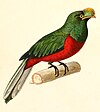
Hornbills are birds found in tropical and subtropical Africa, Asia and Melanesia of the family Bucerotidae. They are characterized by a long, down-curved bill which is frequently brightly coloured and sometimes has a horny casque on the upper mandible. Hornbills have a two-lobed kidney. They are the only birds in which the first and second neck vertebrae are fused together; this probably provides a more stable platform for carrying the bill. The family is omnivorous, feeding on fruit and small animals. They are monogamous breeders nesting in natural cavities in trees and sometimes cliffs. A number of mainly insular species of hornbill with small ranges are threatened with extinction, mainly in Southeast Asia.

Tockus is a genus of birds in the hornbill family, Bucerotidae, which are native to Africa.

Anorrhinus is a genus of hornbills found in forests of Southeast Asia. They are social and typically seen in groups, but only the dominant pair are believed to breed, while other group members act as helpers.

Anthracoceros is a genus of birds in the family Bucerotidae.

Bycanistes is a genus of medium to large, primarily frugivorous hornbills found in the forests and woodlands of Sub-Saharan Africa. They have often been included in the genus Ceratogymna, but today most authorities consider them separate. All species in this genus have black and white plumage. The plumage of the sexes is similar, but the casque of the male is larger than that of the female.

The African grey hornbill is a member of the hornbill family of mainly tropical near-passerine birds found in the Old World. It is a widespread resident breeder in much of sub-Saharan Africa and the southwest of the Arabian Peninsula. The African grey hornbill has escaped or been deliberately released into Florida, USA, but there is no evidence that the population is breeding and may only persist due to continuing releases or escapes.
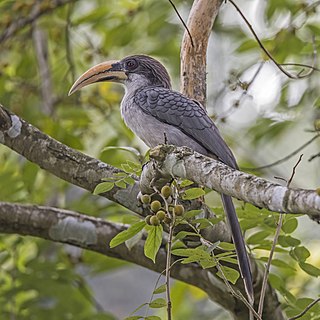
The Sri Lanka grey hornbill is a bird in the hornbill family and a widespread and common endemic resident breeder in Sri Lanka. Hornbills are a family of tropical near-passerine birds found in the Old World.
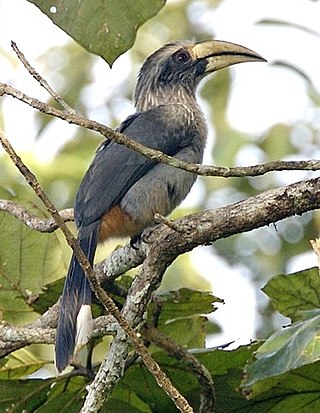
The Malabar gray hornbill is a hornbill endemic to the Western Ghats and associated hills of southern India. They have a large beak but lack the casque that is prominent in some other hornbill species. They are found mainly in dense forest and around rubber, arecanut or coffee plantations. They move around in pairs or small groups, feeding on figs and other forest fruits. Their loud cackling and laughing call makes them familiar to people living in the region.
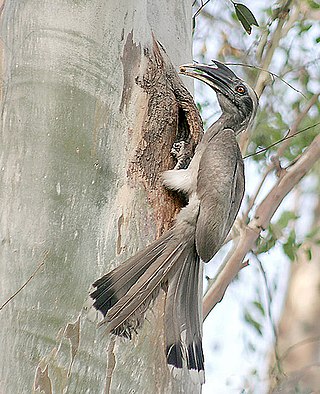
The Indian gray hornbill is a common hornbill found on the Indian subcontinent. It is mostly arboreal and is commonly sighted in pairs. It has grey feathers all over the body with a light grey or dull white belly. The horn is black or dark grey with a casque extending to the point of curvature of the horn. It is one of the few hornbill species found in urban areas in many cities where they are able to make use of large trees in avenues.
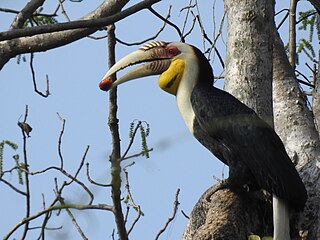
The wreathed hornbill is an Old World tropical bird of the hornbill family Bucerotidae, also called bar-pouched wreathed hornbill due to its distinctive blue-black band on its lower throat sac. It is named after its characteristic long, curved bill that develops ridges, or wreaths, on the casque of the upper mandible in adults. Males are black with a rufous crown, a white upper breast and face, and a yellow featherless throat. Females are uniformly black with a blue throat and are slightly smaller than males.
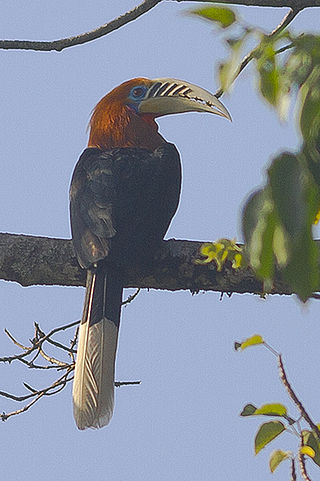
The rufous-necked hornbill is a species of hornbill in Bhutan, northeastern India, especially in Arunachal Pradesh, Indian Subcontinent and Southeast Asia. It is locally extinct in Nepal due to hunting and significant loss of habitat. There are less than 10,000 adults left in the wild. With a length of about 117 cm (46 in), it is among the largest Bucerotine hornbills. The underparts, neck and head are pigmented as a rich rufous in the male, but black in the female.

Bucerotiformes is an order of birds that contains the hornbills, ground hornbills, hoopoes and wood hoopoes. These birds were previously classified as members of Coraciiformes. The clade is distributed in Africa, Asia, Europe and Melanesia.

The black-and-white-casqued hornbill also known as the grey-cheeked hornbill, is a large black and white hornbill. It has an oversized blackish bill with a large casque on top. The female is slightly smaller than the male and has a significantly smaller casque. It is a monogamous species, and pairs nest in suitable tree cavities. The female usually lays up to two eggs. The diet consists mainly of figs, fruits, insects and small animals found in the trees.

The Sulawesi hornbill, also known as the Sulawesi tarictic hornbill, Temminck's hornbill or Sulawesi dwarf hornbill, is a relatively small, approximately 45 cm (18 in) long, black hornbill. The male has a yellow face and throat, and yellowish horn bill with black markings. The female has all-black plumage and a darker bill.

The black hornbill is a species of bird of the hornbill family Bucerotidae. It lives in Asia in Brunei Darussalam, Indonesia, Malaysia, Singapore, Thailand.
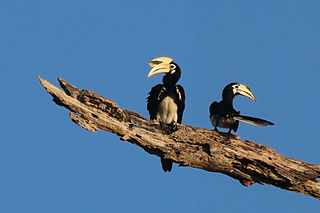
The oriental pied hornbill is an Indo-Malayan pied hornbill, a large canopy-dwelling bird belonging to the family Bucerotidae. Two other common names for this species are Sunda pied hornbill (convexus) and Malaysian pied hornbill.

Rhyticeros is a genus of medium to large hornbills found in forests from Southeast Asia to the Solomons. They are sometimes included in the genus Aceros. On the other hand, most species generally placed in Aceros are sometimes moved to Rhyticeros, leaving Aceros as a monotypic genus only containing the rufous-necked hornbill.

The western red-billed hornbill is a species of hornbill in the family Bucerotidae. It is found from Senegal and Gambia to southern Mauritania and western Mali. There are five species of red-billed hornbills generally recognized now, but all five were once considered conspecific. Some authorities still categorize the group as Tockus erythrorhynchus with the remaining four as its subspecies

The Damara red-billed hornbill is a species of hornbill in the family Bucerotidae. It is found in southwest Angola and northern Namibia. All five red-billed hornbills were formerly considered conspecific.

A casque is an anatomical feature found in some species of birds, reptiles, and amphibians. In birds, it is an enlargement of the bones of the upper mandible or the skull, either on the front of the face, or the top of the head, or both. The casque has been hypothesized to serve as a visual cue to a bird's sex, state of maturity, or social status; as reinforcement to the beak's structure; or as a resonance chamber, enhancing calls. In addition, they may be used in combat with other members of the same species, in the gathering of food, or in thermoregulation.























